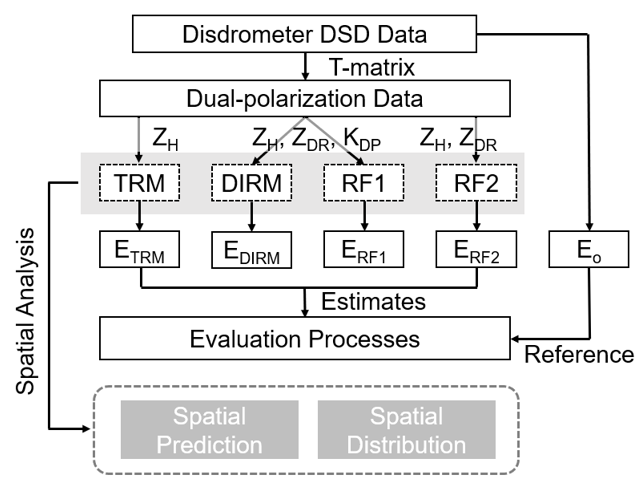The group has made research progress in the direction of Radar-based rainfall energy inversion:

Rainfall energy (E) is a key parameter for understanding the impact of rainfall on the surface, which involves the interaction of raindrops with surface processes. Traditional radar techniques focus on rainfall observation, but there is a research gap in rainfall energy, which involves the interaction of raindrops with surface processes. The team's PhD student, Jingxuan Zhu, was published in November 2024 in the IEEE Transactions on Geoscience and Remote Sensing on November 2024, entitled “DREE-RF: A radar-based rainfall energy estimation model for random forests”.
The team exploited the ability of dual-polarization radar to detect microphysical features of rainfall and proposed for the first time a computational model for direct estimation of E from radar signals. The model investigates the mechanistic correlation between radar dual-polarization parameters and E, and finds that specific differential phases (KDPs) and horizontal reflectivity (ZHs) have the strongest correlation with E. The model is based on the radar's ability to estimate rainfall microphysical features directly from the radar signal. As a result, the study developed radar-based empirical regression and random forest (RF) models to estimate E, where the RF model is in turn subdivided according to the availability of the sensitive KDP.

The results show that the RF model improves the accuracy of estimated E with Pearson correlation coefficients greater than or equal to 0.97 with site-measured E, and further validates the spatial scalability of the model. In addition, both underestimated E estimates compared to the traditional regression model (TRM) and the regression model based on radar inversion of raindrop spectra (DIRM). Whereas, RF has smaller bias (BIAS) and root mean square error (RMSE), as well as higher Pearson correlation.

In addition, the RF model proposed in this study has good spatial extrapolation ability, and it is found that TRM overestimates E, DIRM underestimates E with large errors, and RF model performs the best and matches well with the real data.The Pearson's correlation coefficient and the NSE value of the RF model are significantly better than the other models, and the error metrics are lower, which shows its superiority in the cross-site rainfall energy estimation.

This research not only enhances our understanding of rainfall processes in the context of climate change, but also has great potential for application in areas such as hydrological modeling, flood prediction, and agricultural planning. With the advancement of radar technology and the optimization of machine learning models, we are expected to manage and predict rainfall-related water resource problems more accurately in the future.
First author: Dr Jingxuan Zhu
Corresponding author: Prof Qiang Dai
Other authors: Dr Yuanyuan Xiao, Associate Professor Jun, Lecturer Zhuo Lu
Link to the paper: https://ieeexplore.ieee.org/document/10742511